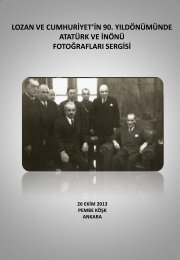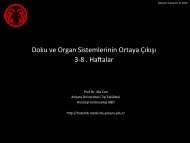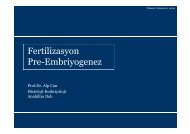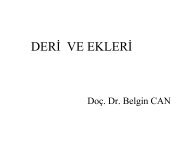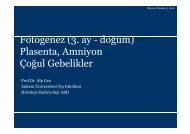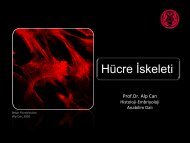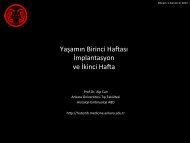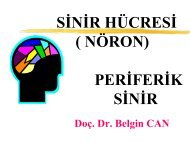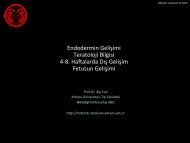dosya indir - ankaratiphastaneleri
dosya indir - ankaratiphastaneleri
dosya indir - ankaratiphastaneleri
You also want an ePaper? Increase the reach of your titles
YUMPU automatically turns print PDFs into web optimized ePapers that Google loves.
S86<br />
J.P. Nolan ve ark.<br />
in anoxic-ischaemic coma. Lancet 1998; 352:1808-12.<br />
385. Booth CM, Boone RH, Tomlinson G, Detsky AS. Is this patient<br />
dead, vegetative, or severely neurologically impaired? Assessing<br />
outcome for comatose survivors of cardiac arrest. Jama<br />
2004; 291:870-9.<br />
386. Edgren E, Hedstrand U, Kelsey S, Sutton-Tyrrell K, Safar P. Assessment<br />
of neurological prognosis in comatose survivors of<br />
cardiac arrest. BRCT I Study Group. Lancet 1994; 343:1055-9.<br />
387. Tiainen M, Roine RO, Pettila V, Takkunen O. Serum neuronspecific<br />
enolase and S-100B protein in cardiac arrest patients<br />
treated with hypothermia. Stroke 2003; 34:2881-6.<br />
388. Fogel W, Krieger D, Veith M, et al. Serum neuron-specific enolase<br />
as early predictor of outcome after cardiac arrest. Crit Care<br />
Med 1997; 25:1133-8.<br />
389. Mussack T, Biberthaler P, Kanz KG, et al. Serum S-100B and interleukin-8<br />
as predictive markers for comparative neurologic<br />
outcome analysis of patients after cardiac arrest and severe traumatic<br />
brain injury. Crit Care Med 2002; 30:2669-74.<br />
390. Mussack T, Biberthaler P, Kanz KG, Wiedemann E, Gippner-<br />
Steppert C, Jochum M. S-100b, sE-selectin, and sP-selectin for<br />
evaluation of hypoxic brain damage in patients after cardiopulmonary<br />
resuscitation: pilot study. World J Surg 2001; 25:539-<br />
43; discussion 44.<br />
391. Rosen H, Karlsson JE, Rosengren L. CSF levels of neurofilament<br />
is a valuable predictor of long-term outcome after cardiac arrest.<br />
J Neurol Sci 2004; 221:19-24.<br />
392. Rosen H, Rosengren L, Herlitz J, Blomstrand C. Increased serum<br />
levels of the S-100 protein are associated with hypoxic<br />
brain damage after cardiac arrest. Stroke 1998; 29:473-7.<br />
393. Meynaar IA, Straaten HM, van der Wetering J, et al. Serum<br />
neuron-specific enolase predicts outcome in post-anoxic coma:<br />
a prospective cohort study. Intensive Care Med 2003;<br />
29:189-95.<br />
394. Rosen H, Sunnerhagen KS, Herlitz J, Blomstrand C, Rosengren<br />
L. Serum levels of the brain-derived proteins S-100 and NSE<br />
predict long-term outcome after cardiac arrest. Resuscitation<br />
2001; 49:183-91.<br />
395. Schreiber W, Herkner H, Koreny M, et al. Predictors of survival<br />
in unselected patients with acute myocardial infarction requiring<br />
continuous catecholamine support. Resuscitation 2002;<br />
55:269-76.<br />
396. Schoerkhuber W, Kittler H, Sterz F, et al. Time course of serum<br />
neuron-specific enolase. A predictor of neurological outcome<br />
in patients resuscitated from cardiac arrest. Stroke 1999;<br />
30:1598-603.<br />
397. Bottiger BW, Mobes S, Glatzer R, et al. Astroglial protein S-<br />
100 is an early and sensitive marker of hypoxic brain damage<br />
and outcome after cardiac arrest in humans. Circulation 2001;<br />
103:2694-8.<br />
398. Martens P, Raabe A, Johnsson P. Serum S-100 and neuronspecific<br />
enolase for prediction of regaining consciousness after<br />
global cerebral ischemia. Stroke 1998; 29:2363-6.<br />
399. Zingler VC, Krumm B, Bertsch T, Fassbender K, Pohlmann-<br />
Eden B. Early prediction of neurological outcome after cardiopulmonary<br />
resuscitation: a multimodal approach combining<br />
neurobiochemical and electrophysiological investigations may<br />
provide high prognostic certainty in patients after cardiac arrest.<br />
Eur Neurol 2003; 49:79-84.<br />
400. Zandbergen EG, de Haan RJ, Hijdra A. Systematic review of<br />
prediction of poor outcome in anoxic-ischaemic coma with biochemical<br />
markers of brain damage. Intensive Care Med 2001;<br />
27:1661-7.<br />
401. Synek VM. Validity of a revised EEG coma scale for predicting<br />
survival in anoxic encephalopathy. Clin Exp Neurol 1989;<br />
26:119-27.<br />
402. Moller M, Holm B, Sindrup E, Nielsen BL. Electroencephalographic<br />
prediction of anoxic brain damage after resuscitation<br />
from cardiac arrest in patients with acute myocardial infarction.<br />
Acta Med Scand 1978; 203:31-7.<br />
403. Scollo-Lavizzari G, Bassetti C. Prognostic value of EEG in postanoxic<br />
coma after cardiac arrest. Eur Neurol 1987; 26:161-70.<br />
404. Bassetti C, Karbowski K. [Prognostic value of electroencephalography<br />
in nontraumatic comas]. Schweiz Med Wochenschr<br />
1990; 120:1425-34.<br />
405. Bassetti C, Bomio F, Mathis J, Hess CW. Early prognosis in coma<br />
after cardiac arrest: a prospective clinical, electrophysiological,<br />
and biochemical study of 60 patients. J Neurol Neurosurg<br />
Psychiatry 1996; 61:610-5.<br />
406. Rothstein TL. Recovery from near death following cerebral anoxia:<br />
A case report demonstrating superiority of median somatosensory<br />
evoked potentials over EEG in predicting a favorable<br />
outcome after cardiopulmonary resuscitation. Resuscitation<br />
2004; 60:335-41.<br />
407. Berkhoff M, Donati F, Bassetti C. Postanoxic alpha (theta) coma:<br />
a reappraisal of its prognostic significance. Clin Neurophysiol<br />
2000; 111:297-304.<br />
408. Kaplan PW, Genoud D, Ho TW, Jallon P. Etiology, neurologic<br />
correlations, and prognosis in alpha coma. Clin Neurophysiol<br />
1999; 110:205-13.<br />
409. Yamashita S, Morinaga T, Ohgo S, et al. Prognostic value of<br />
electroencephalogram (EEG) in anoxic encephalopathy after<br />
cardiopulmonary resuscitation: relationship among anoxic period,<br />
EEG grading and outcome. Intern Med 1995; 34:71-6.<br />
410. Ajisaka H. Early electroencephalographic findings in patients<br />
with anoxic encephalopathy after cardiopulmonary arrest and<br />
successful resusitation. J Clin Neurosci 2004; 11:616-8.<br />
411. Rothstein TL, Thomas EM, Sumi SM. Predicting outcome in<br />
hypoxic-ischemic coma. A prospective clinical and electrophysiologic<br />
study. Electroencephalogr Clin Neurophysiol 1991;<br />
79:101-7.<br />
412. Edgren E, Hedstrand U, Nordin M, Rydin E, Ronquist G. Prediction<br />
of outcome after cardiac arrest. Crit Care Med 1987;<br />
15:820-5.<br />
413. Sorensen K, Thomassen A, Wernberg M. Prognostic significance<br />
of alpha frequency EEG rhythm in coma after cardiac arrest.<br />
J Neurol Neurosurg Psychiatry 1978; 41:840-2.



